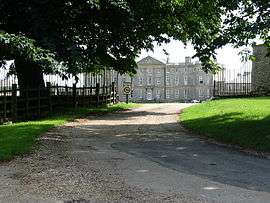Daniel Finch, 8th Earl of Winchilsea
Daniel Finch, 8th Earl of Winchilsea and 3rd Earl of Nottingham, KG, PC (24 May 1689 – 2 August 1769) was a British politician.
The Earl of Winchilsea KG PC | |
|---|---|
%2C_8th_Earl_of_Winchilsea%2C_3rd_Earl_of_Nottingham%2C_by_Thomas_Worlidge.jpg) Daniel Finch (1689-1769), 8th Earl of Winchilsea, 3rd Earl of Nottingham (Thomas Worlidge) | |
| Lord President of the Council | |
| In office 12 July 1765 – 30 July 1766 | |
| Monarch | George III |
| Prime Minister | The Marquess of Rockingham |
| Preceded by | The Duke of Bedford |
| Succeeded by | The Earl of Northington |
| Member of the England Parliament for Rutland | |
| Preceded by |
|
| Succeeded by |
|
| Personal details | |
| Born | Daniel Finch 24 May 1689 |
| Died | 2 August 1769 (aged 80) |
| Resting place | Eastwell, Kent, England |
| Spouse(s) |
|
| Children | 5 daughters |
| Parents | |
Early life

Styled Lord Finch until 1730, he was the eldest son of Daniel Finch, 2nd Earl of Nottingham, and his second wife Anne Hatton, daughter of Christopher Hatton, 1st Viscount Hatton. His father was a prominent Tory politician who had been one of the few leading Tories to actively support the Hanoverian succession. He succeeded to his fathers titles and his estate at Burley-on-the-Hill, Rutland in 1730.[1]
Career
As Lord Finch, he was elected when only 21 as Member of Parliament for Rutland. He remained its member until he succeeded to the Earldom in 1730, also serving as comptroller of the royal household from 1725 to 1730. Winchilsea supported the creation of London's Foundling Hospital, a charity providing home and education for some of the capital's many abandoned children. Winchilsea was one of the original governors for this organisation, founded in 1739.
Although his father had been a supporter of Walpole, Winchilsea became instead a supporter of Lord Carteret in the so-called "Patriot Opposition". When Carteret became leading minister in 1742, Winchilsea joined as well, becoming First Lord of the Admiralty (1742–1744). Later on, he allied himself with Newcastle and the Old Whigs, and served as Lord President in the Rockingham administration (1765–1766).
He was made a Knight of the Garter in 1752.[1]
Personal life
He first married Lady Frances Feilding, daughter of Basil Feilding, 4th Earl of Denbigh and Hester Firebrace, with whom he had a daughter:[1]
- Lady Charlotte Finch, who died unmarried.[1]
He later married Mary Palmer, the second daughter and co-heiress of Sir Thomas Palmer, 4th Baronet, of Wingham and Elizabeth Marsham (sister of Robert Marsham, 1st Baron Romney and daughter of Sir Robert Marsham, 4th Baronet. They had eight daughters, only four of whom survived to adulthood, including:[1]
- Lady Heneage Finch (d. 1820), who married, as his second wife, Maj.-Gen. Sir George Osborn, 4th Baronet, in 1788.[1]
- Lady Essex Finch, who died unmarried.[1]
- Lady Hatton Finch (d. 1829), who died unmarried.[1]
- Lady Augusta Finch (d. 1797), who died unmarried.[2] He lived at Eastwell Park.
He died in 1769 and was buried at Eastwell. His titles, together with his estates at Burley-on-the-Hill and elsewhere, passed to his nephew George Finch, son of his brother, the diplomat William.[1] He left his Kentish properties, such as Eastwell Park, to his other nephew George Finch-Hatton, son of his brother Edward.
References
- "Winchilsea, Earl of (E, 1628)". www.cracroftspeerage.co.uk. Heraldic Media Limited. Retrieved 17 June 2020.
- The New Peerage; Or, Present State of the Nobility of England, 1769, p77
External links

| Parliament of Great Britain | ||
|---|---|---|
| Preceded by Richard Halford The Earl of Harborough |
Member of Parliament for Rutland 1710–1730 With: John Noel 1710–1711, 1715–1719 Richard Halford 1711–1713 The Lord Sherard 1713–1715 Marquess of Granby 1719–1721 Sir Thomas Mackworth, Bt 1721–1727 John Noel 1727–1728 Thomas Noel 1728–1730 |
Succeeded by William Burton Thomas Noel |
| Political offices | ||
| Preceded by Paul Methuen |
Comptroller of the Household 1725–1730 |
Succeeded by Sir Conyers Darcy |
| Preceded by Sir Charles Wager |
First Lord of the Admiralty 1742–1744 |
Succeeded by The Duke of Bedford |
| Preceded by The Earl Temple |
First Lord of the Admiralty 1757 |
Succeeded by The Lord Anson |
| Preceded by The Duke of Bedford |
Lord President of the Council 1765–1766 |
Succeeded by The Earl of Northington |
| Honorary titles | ||
| Preceded by The Duke of Newcastle |
Senior Privy Counsellor 1768–1769 |
Succeeded by The Duke of Queensberry and Dover |
| Peerage of England | ||
| Preceded by Daniel Finch |
Earl of Winchilsea 1730–1769 |
Succeeded by George Finch |
| Earl of Nottingham 7th creation 1730–1769 | ||
| Viscount Maidstone 1730–1769 | ||
| Baron Finch of Daventry 1730–1769 | ||
| Baronetage of England | ||
| Preceded by Daniel Finch |
Baronet (of Raunston, Buckinghamshire) 1730–1769 |
Succeeded by George Finch |
| Baronet (of Eastwell, Kent) 1730–1769 | ||
.svg.png)